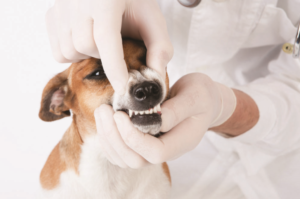Learning the importance of all the information concerning the dental health of your pets.
Dental health is an important part of your pet’s overall well being. 85% of pets already have evidence of periodontal disease (including inflammation of gums and the loss of bone and soft tissue around the teeth) by the age of 3. If not detected and treated at an early stage, this may lead to serious health conditions beyond oral health, including kidney, liver and heart functions. It’s important to be aware of the causes of dental problems, and to be able to identify the signs that your pet is suffering from periodontal disease.

Dental problems in pets start when plaque (sticky residue from saliva, food, and drink; it can encourage the growth of bacteria) hardens into tartar (a yellowish or brownish mineral buildup).
Tartar above the gum line can easily be seen and removed, but plaque below the gum line is damaging, and sets the stage for infection and injury to the jawbone.
Every day is an opportunity to improve your pet’s oral health. Pet lovers can extend their dog or cat’s longevity and quality of life by adding oral care to their routine.
WHY ARE TEETH IMPORTANT? – The most vital use for your pet’s teeth is for tearing and chewing food. Cats and dogs are carnivores, so they need to be able to do this. They also use their teeth to defend themselves in fights, and to grip things they are carrying. When a pet loses its teeth, it will require a special soft diet.
TEETH TRIVIA – Your grown dog should have 42 teeth, while your grown cat should have 30. Go ahead and count them the next time you clean their teeth—if they let you!
There are various ways to help your pets with their dental health woes. Veterinarians offer dental health plans for your cats and dogs that best fit your lifestyle. With the expert guidance of your veterinarian, below are some tips you can choose:
· Professional cleaning: The American Animal Hospital Association (AAHA) recommends a regular professional teeth cleaning for your dog or cat, starting at 1 or 2 years old, depending on their size. Your pet will be put under anesthesia so that each tooth will receive proper attention and care, including under the gum line.
· Home care: An at home dental care routine for your pet
is an important part of tooth maintenance. Veterinary experts recommend regular tooth brushings and, if possible, multiple times a week. This will help remove most plaque before it can mineralize into tartar. If a toothbrush scares your pet, you can get nearly the same result by wiping their teeth with a gauze pad or dental wipe from your local pet supply store.
· Dental treats: Some pet food and treat products offer additional dental health benefits. In order for pet food makers to make a claim related to dental health, such as cleansing teeth or preventing tartar buildup, the package must communicate how that effect is achieved (such as small ridges or a porous consistency).
Take your cat or dog to the veterinarian if you observe any of the following:
• Bad breath
• Broken teeth
• Abnormal chewing or dropping food from their mouth
• Reduced appetite or refusal to eat
• Signs of blood in your pet’s water bowl or on chew toys
• Swelling in the areas surrounding the mouth
This article is courtesy of the Pet Food Institute, in line with its responsible pet ownership advocacy “Well Fed, Well Nurtured” campaign with the Veterinarian Practitioners Association of the Philippines. For more information on responsible pet care, visit www. petfoodinstitute.org and follow PFI on Twitter @USPetFood.
This story appeared in Animal Scene’s June 2017 issue.






